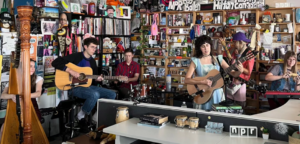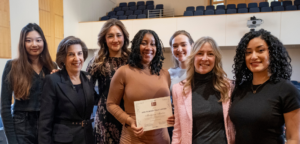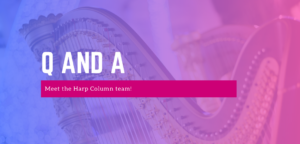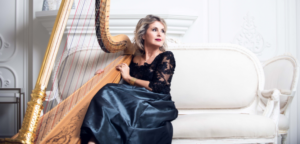I first met Joris Beets when he came to the Dutch Harp Festival in 2014 to show off his new invention – the Delta harp. Since then, I’ve seen the instrument gradually gain attention in the harp world, eventually even winning over Salvi harps. Just recently, they officially unveiled the Delta harp as their latest model, and it’s becoming available in harp stores around the world. This is no ordinary harp – worn with a shoulder strap like an electric guitar, it’s an instrument for rock stars. You may have seen artists such as Remy van Kesteren and Sasha Boldachev exploring what new sonic worlds this bold design opens up, or you may even have taken it for a ride yourself at a recent harp festival exposition. Whether you fall in love with it or find it hopelessly strange, it represents the next step in the harp’s evolution, so don’t say I didn’t warn you! I got back in touch with Joris (his full name is pronounced “Yoris Bates”) – Dutch musician, designer, and engineer (now living in London) – to get his story.
Tell us about the design of the Delta harp. What makes it unique?
It’s unique in various ways: it offers a completely new interaction, opens up new techniques, a new sound, stage presence and of course the aesthetic paradigm. In terms of interaction, you can wear it like a large bass guitar, allowing you to walk across the stage, tap effects pedals, and easily put it down to swap with other instruments you might play. In terms of techniques, the strings run over a bridge, which allows you to bend the pitch of the strings like you would on a guitar. The fact that you can stand with your hands relaxed instead of with angled wrists means you can play fast repetitive patterns for a long time without strain. The design also allows for reverting back to playing in the ‘traditional’ up-right way.
Then there’s the sound. The new pick up technology and the self-shielding electronics allow for a much cleaner and fuller bass than any previous electric harps out there, and the fact that there are extra bass strings compared to harps of this size helps to make this a really nice bassy harp, suitable for playing contemporary music. The new shape and layout are not only space efficient, allowing for a large string range on a small surface, but the choice of straight and tensed lines in combination with the materials and colors used mean a definite break with the past.
What kind of music do you like to play on the Delta harp?
I’m an improviser and multi-instrumentalist, and I play in various bands. For instance, I tour regularly with an improvisation collective called Orchestra Elastique, where I play Delta harp but also various middle eastern and afro-brazillian percussion instruments, saz, accordion, piano, and drums. I cross various musical genres from jazz, krautrock and psychedelic metal to doing live scores to silent films. On the Delta harp you can adjust to any genre.

Joris Beets, inventor of the Delta Harp, performs at the Dutch Harp Festival in 2014. Photo by Elizabeth Jaxon.
What’s your background?
I was born in Amsterdam and grew up in hippie communes with my amazing parents and brother. I studied Industrial Design Engineering at the Delft University of Technology in the Netherlands, and I’ve lived and worked in Tokyo, Brazil, Istanbul and now in London. I work as a musician, as a director of design in a large firm, and as a private inventor with various patents against my name.
How did you come up with the idea for the Delta harp?
The harp chose me at a very early age. I was incredibly determined. My parents initially gave in and got me a small harp, and I played for years, developing quite an unusual improvised style, upsetting to some teachers but loved by others. However, when I reached the age of 13, I realised it wasn’t a particularly cool instrument to be playing as a guy. There’s a huge stigma; harpists are dreamy females in long dresses. I started focusing on other instruments, playing drums and percussion in bands. In my university years, however, I started missing my harp, picked it up and started playing it in bands. As much as I loved the reach and sound of the harp, playing in bands also exposed its limitations. The hassle of transporting, the endless tuning, the amplification problems, the static appearance and although perhaps unusual… also just looking rather uncool. By then there were some ‘electrified’ harps out there, but with their fizzy bass, naff appearance, and limitied options, they just didn’t do it for me.
So, I decided to redesign the harp from scratch. In my first prototypes, I focused on the interaction. They looked awful, like pieces of furniture with strings, but they allowed me to develop the way of playing it like a guitar and running the strings over a bridge. I was always playing the prototypes in bands to inform the next iteration.
I then addressed the sound by developing a new technology to pick up the vibrations. I added some more bass strings and developed new electronics to allow for the bass frequencies to be cranked up in volume without any humms or buzzes and for the electronics to be compatible with any effect pedal or studio equipment. Then, I redesigned the body using 3D CAD and force flow analyses to find the most efficient shape around the components and string tensions while crafting it into a beautiful design.

Joris Beets presents the Delta Harp at the 2016 Dutch Harp Festival. Photo by Jeroen Berends.
What response have you experienced from the harp world since?
Funnily enough, the first people that were interested in the Delta harp were not from the harp world. For instance, an established oboist, Marlies van Gangelen, looking to play an additional and very different instrument saw me play the Delta at a concert in London and asked me to build her one. She then learned to play harp and now plays at a high level at for instance the BBC night of the Proms.
As for the harp world, initially from established harp builders I just got frowns, laughs, and disbelief, but as the community of Delta harp owners and enthusiasts grew and started to include bigger names like Remy van Kesteren, this started to change. By then, I had a small team of engineers perfecting and producing Delta harps. When I presented the harp at the World Harp Congress in Sydney, in 2015, it was clear that the Delta was striking a chord with anyone interested in something new. All the cool cats were at my booth, so to say. Everyone was so enthusiastic – it was amazing! And they represented a very nice cross section of musical genres: jazz harpists like Mary Doumany, electronic musicians like Jake Meadows, and classical harpists like Eleanor Turner and Sacha Boldachev all wanted one. Enzo Vizzone, director at Salvi, was there too. He noticed this, and that’s how we started talking.
How did you end up partnering with Salvi harps?
From initial conversations with Marco Salvi, a perfect match became apparent: the promising Delta invention and my expertise in design, technology, and innovation combined with Salvi’s amazing heritage, craftsmanship, state-of-the art production facilities, and worldwide distribution networks. It was clear Enzo, Marco, and I shared a vision, that this could give the harp as an instrument a new chapter, in which it becomes an instrument of choice for next generations, penetrating and shaping music to come, like the saxophone did over a century ago.
Working with Salvi has been amazing. It’s an honest, family-run business. Colleagues care about each other and are passionate about their work; they take pride in knowing they are the best. They have been extremely enthusiastic, and working closely with their open-minded head of R&D, Giorgio Peirano, has been a bliss. By the summer of 2016, the production process was set up, and now over a hundred “Delta by Salvi” harps have already found their way across the globe.
For harpists accustomed to the classical harp, what would you say are the technical obstacles to mastering the Delta harp?
Classical acoustic harp players initially pluck the strings much harder than necessary. People need to get used to the different angle of looking at the strings, and most people need to adjust the strap length and position of their feet a few times to find the most comfortable posture. But they all seem to be fine, either immediately or after a few days of playing around. Then of course, using bass and guitar effects is a whole new, exciting world to people that have never tried that. You can spend many evenings exploring new effects and finding the best sound for the band or genre you play in. There are very cheap, entry-level, digital interfaces (like line6 Sonic Port) that allow you to just plug into your iPhone and use that as effects emulator. One level up would be using an all-in-one multi-effects pedal (like the Boss ME25), and if you’re serious you can get individual analogue effect processors.
What are Salvi’s plans to release the harp?
The Salvi version of the harp was first launched in the Netherlands, October 2016, at the Dutch Harp Festival, and a few days later at the enormous music fair in Shanghai. Since then, it has been released in various countries. Currently, it is being demoed by Sasha [Boldachev] at the NAMM in the USA, and further launches are planned for the next couple of months.
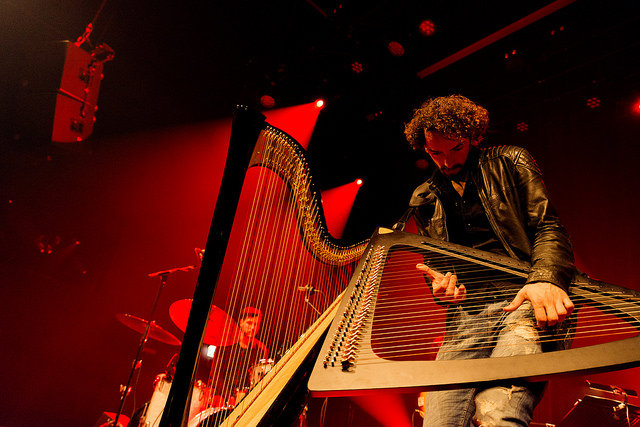
Remy van Kesteren plays the Delta Harp at the 2016 Dutch Harp Festival. Photo by Jeroen Berends.
Where do you see the Delta harp in the future?
The harp, as an instrument, deserves much more space in the world of music than it is currently occupying. I believe the Delta harp will be an important step in realising its full potential. If I were that 13-year-old boy again now, I wouldn’t ditch harps – I’d move on to a Delta harp. And some other kid in my school class would probably join me. I think this is only the beginning of a next chapter.
Check out the full instrument specs at Delta-Harp.com.









